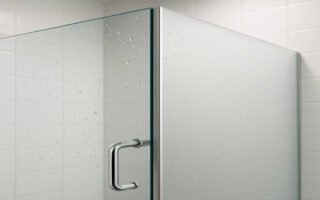Have you ever scrolled through social media and stumbled upon a post urging you to wrap your doorknob in aluminum foil when you’re home alone? If so, you’re not alone. This quirky tip has gone viral, sparking curiosity and debate across the internet. But what’s the real story behind this trend? Why put foil on the doorknob, and does it make your home safer?
Let’s face it—home security is a top concern for many, especially when you’re by yourself. The idea of a simple, low-cost hack that could deter intruders is appealing. That’s why the aluminum foil doorknob hack has gained so much traction. But as with many viral trends, the truth is often more complicated than the claims.
In this article, we’ll delve into the origins of this hack, separate fact from fiction, and examine the practical applications of aluminum foil on door knobs. We’ll also share expert advice on what works for home security, so you can make informed decisions about keeping your home safe and secure.
By the end, you’ll know precisely why people put foil on doorknobs, what it can and can’t do, and the best ways to protect yourself when you’re home alone.
The Origin of the Aluminum Foil Door Knob Hack
How the Hack Spread Online
The aluminum foil doorknob hack didn’t start in a security expert’s handbook—it exploded on social media. Platforms like TikTok, Facebook, and YouTube are filled with videos and posts showing people wrapping their doorknobs in shiny foil, often with dramatic claims about safety and security. Online ads and clickbait articles have only fueled the fire, making it seem like a must-try trick for anyone concerned about home security.
You may also read (top types of home garage doors and how to choose the right one).
What the Hack Claims
So, what exactly does this hack promise? Here are the most common claims:
- Foil makes noise if someone tries to turn the knob, alerting you to an intruder.
- It makes the knob harder to grip or turn, supposedly deterring break-ins.
- If the foil is found broken or disturbed, it indicates that someone has attempted to enter.
These ideas sound clever, but are they based on objective evidence?
Actual Origins: Painting and Static Electricity
Surprisingly, the true origins of wrapping door knobs in aluminum foil have little to do with security. The practice is rooted in practical household tasks:
- Painting: Homeowners and painters have long used foil to protect doorknobs from paint splatters. It’s quick, molds easily, and peels off cleanly when the job is done.
- Static Electricity: In dry climates, foil can help reduce static shocks by dispersing electrical charges on metal knobs.
The security angle is a recent twist, driven mainly by viral content rather than expert advice or proven results.
Debunking the Security Myths Around Foil on Door Knobs
Let’s break down the most popular security claims about the aluminum foil doorknob hack and see how they hold up under scrutiny.
Myth 1: Foil Makes Noise to Alert You
The idea here is simple: if someone tries to turn your foil-wrapped knob, the crinkling sound will wake you up or alert you to danger. In reality, the noise produced by foil is minimal. Unless you’re sleeping right next to the door, you’re unlikely to hear it, primarily through a closed door or from another room. It’s not a reliable alarm system by any stretch.
Myth 2: Foil Makes the Doorknob Harder to Turn or Pick
Some believe that foil creates a physical barrier, making the knob slippery or difficult to turn. But aluminum foil is thin and fragile. A determined intruder can easily tear it off or ignore it altogether. It doesn’t stop anyone with bad intentions, nor does it make picking a lock any harder.
Myth 3: Broken Foil Signals Attempted Break-In
Another claim is that if you find the foil disturbed or broken, it’s a sign someone tried to get in. The problem? Foil can be damaged by pets, kids, weather, or even by accident. It’s not a reliable indicator of a security threat. You might end up worrying over nothing, or worse, miss a genuine sign of trouble.
Expert Opinions and Security Advice
Security professionals are clear: wrapping your doorknob in foil does not make your home safer. Instead, they recommend proven measures like:
- Installing quality locks and deadbolts
- Using security cameras and alarm systems
- Reinforcing doors and windows
These steps are far more effective than any viral hack.
Potential Risks of Using Foil as a Security Signal
Ironically, using foil as a “security” measure could backfire. It might signal to others that you’re alone or feel vulnerable, potentially attracting unwanted attention. In some cases, it could even make your home a target for opportunistic intruders.
Practical and Beneficial Uses of Aluminum Foil on Door Knobs
While the security claims don’t hold up, aluminum foil does have some genuinely helpful household applications. Let’s explore the real benefits.
Use 1: Protecting Door Knobs During Painting
If you’ve ever painted a door, you know how tricky it is to avoid getting paint on the hardware. Aluminum foil is a painter’s best friend:
- It molds perfectly around any shape.
- It’s quick to apply and remove.
- It keeps paint off your knobs, saving you time on cleanup.
Compared to painter’s tape, foil is often faster and more effective, especially for oddly shaped knobs.
Use 2: Reducing Static Electricity Shocks
In dry weather, static electricity can build up on metal surfaces, leading to those annoying little shocks. Wrapping your doorknob in foil helps by:
- Dispersing static charges safely
- Reducing the chance of getting zapped when you touch the knob
It’s a simple solution to a common household annoyance.
Use 3: Temporary Moisture Barrier
Metal door knobs can corrode over time, especially in humid environments. Aluminum foil can act as a short-term shield:
- It blocks moisture from reaching the metal
- It’s easy to remove and replace as needed
Just remember, this is a temporary solution, not a substitute for regular maintenance.
Comparison with Other Materials
Let’s see how aluminum foil stacks up against painter’s tape for these uses:
Use CaseAluminum FoilPainter’s Tape
Protecting during painting, molds are efficient, quick to apply and remove, but may take longer and may not fit odd shapes well.
Reducing static electricity Conducts and disperses static charges—no effect on static electricity.
Temporary moisture barrier: Provides short-term protection. Limited moisture protection.
Cost and convenience: Cheap, widely available, easy to use. Slightly more expensive, more time-consuming
You may also read (how to choose the right locksmith for your home).
Summary of Practical Uses:
- Painting protection
- Static electricity reduction
- Temporary moisture barrier
Key Finding:
Aluminum foil is a handy, low-cost tool for household tasks—but not for home security.
Why People Still Use Foil on Door Knobs When Alone
Despite the lack of evidence, many people still reach for the foil when they’re home alone. Why is that?
Psychological Comfort and Perceived Safety
Sometimes, taking any action—no matter how small—can make us feel safer. Wrapping a doorknob in foil gives a sense of control, especially when you’re feeling vulnerable. It’s a way to “do something” rather than nothing.
Influence of Online Trends and Misinformation
Social media is a powerful force. Viral videos and posts can make even the most questionable hacks seem legitimate. When you see others doing it, you might feel compelled to try it yourself, even if the evidence is shaky.
Low-Cost, Easy-to-Apply “Security” Measure
Let’s be honest: real security upgrades can be expensive. Foil is inexpensive, readily available, and can be applied in seconds. For some, it feels like a quick win—better than nothing, right?
Cultural or Anecdotal Reasons
In some communities, household hacks and folk wisdom are passed down through generations. Even if the science isn’t there, the tradition persists.
Better Alternatives for Home Security When Alone
If you’re serious about keeping your home safe, there are far better options than aluminum foil. Here’s what the experts recommend:
Lock Your Doors Properly and Use Deadbolts
- Always lock all doors and windows, even when you’re home.
- Upgrade to deadbolts and high-quality locks for added protection.
Install Security Cameras or Doorbell Cameras
- Modern cameras are affordable and easy to install.
- They let you monitor your home in real time and deter would-be intruders.
Use Alarms and Motion Sensors
- Alarm systems provide instant alerts if someone tries to break in.
- Motion sensors can trigger lights or alarms, scaring off trespassers.
Neighborhood Watch and Community Safety Tips
- Get to know your neighbors and look out for each other.
- Join or start a neighborhood watch program for added peace of mind.
Practical Tips for Feeling Safe When Home Alone
- Don’t hide spare keys outside—give one to a trusted neighbor instead.
- Use timers for lights and electronics to make your home look occupied.
- Keep your phone nearby and have the emergency numbers readily available.
Table: Key Home Security Best Practices
Security Measure Expert Recommendation
Reinforce doors and windows. Use deadbolts, anti-snap locks, and security film.
Install a home security system. Include sensors, cameras, and alarms
Outdoor lighting: Use motion-activated or timed lights
Secure garage and outbuildings. Use high-quality locks, consider innovative garage systems
Lock all doors and windows. Make it a daily habit
Avoid hiding spare keys outside. Use trusted neighbors or smart locks
Neighborhood watch/community involvement: Join or start a program
Appear occupied when away. Use timers for lights and electronics
Secure Wi-Fi and digital devices. Use strong passwords, update regularly
Store valuables in a safe. Use fireproof, insurance-approved safes.
You may also read (benefits of installing aluminum awnings on your home).






